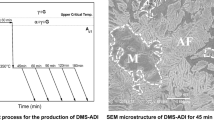Abstract
During the last few years, researchers have sought new ductile iron (DI) applications focusing on the development of mixed microstructures, such as ferritic-bainitic or ferritic-martensitic. These kinds of structures result in DI with a good combination of mechanical properties, compared to other conventional DI. The combination of properties offered by the mixed structure DI, particularly in “dual phase austempered ductile iron” (ADI) has opened new horizons for cast iron to replace steel castings and forgings in many engineering applications. This new DI has a particular microstructure composed of different amounts and morphologies of ausferrite and free ferrite.
Dual phase ADI microstructures have afforded more opportunities for DI applications, acquiring better combinations of strength, ductility and toughness. This review describes the methodologies used to obtain this new kind of DI and the principal mechanical properties.
Similar content being viewed by others
References
http://www.ductile.org/didata/Section2/2intro.htm#The%20Ductile%20Iron%20Advantage.
ASM Handbook Vol.1, “Properties and Selections: Irons and Steel,” Section: “Alloy Cast Iron” pp. 75–96. 9th edition, USA (1992).
Ductile Iron Data for Design Engineers, Section II. QIT-Fer et Titane Inc. USA, (1990).
Voigt, R., Eldoky, M. and Chiou, H., “Crack Initiation and Propagation in As-Cast and Fully Pearlitic Ductile Cast Irons,” AFS Transactions, vol. 94, pp. 637–644 (1986).
Hafiz, M. “Mechanical Properties of SG-Iron with Different Matrix Structure,” Journal of Materials Science, vol. 36, no. 5, pp. 1293–1300 (2001).
Radishi, A. and Moshrefi-Torbati M., “Effect of Tempering Conditions on the Mechanical Properties of Ductile Cast Iron with Dual Matrix Structure (DMS),” Materials Letters, vol. 45, pp. 203–207 (2000).
He (He Zerong), Z. R., Lin, G. X. and Ji, S., “Deformation and Fracture of Cast Iron with an Optimized Microstructure,” Materials Characterization, vol. 38, pp. 251–258 (1997).
Kobayashi, T. and Yamada S., “Effect of Holding Time in the (α + γ) Temperature Range on Toughness of Specially Austempered Ductile Iron,” Metallurgical and Materials Transactions, vol. 27A, pp. 1961–1971 (1996).
ASM Metals Handbook, vol. 15: “Casting”, 9th Edition, USA, p. 629 (1988).
Angus, H.T., “Cast Iron: Physical and Engineering Properties,” chapter 1, pp. 1–21, 2nd edition, © Butterworth & Co. (Publishers) Ltd. USA (1976).
Lagarde, M., Basso, A., Dommarco, R. and Sikora, J., “Development and Characterization of a New Type of Ductile Iron with a Novel Multi-Phase Microstructure,” ISIJ International, vol. 51, no. 4, pp. 645–650 (2011).
Galarreta I, Boeri R. and Sikora J. “Free Ferrite in Pearlitic Ductile Iron,” International Journal of Cast Metal Research, vol. 9, no. 6, pp 353–358 (1997).
Aranzabal J, Serramoglia G. and Rousiere D., “Development of a New Mixed (Ferritic — Ausferritic) Ductile Iron for Automotive Suspension Parts,” International Journal of Cast Metal Research, vol. 16, no. 1, pp. 185–190 (2002).
Wade, N. and Ueda, Y., “Mechanical Properties of Ductile Cast Iron with Duplex Matrix,” Transactions of the Iron and Steel Institute of Japan, vol. 21, no. 2, pp. 117–126 (1981).
Verdu, C., Adrien, J. and Reynaud, A., “Contributions of Dual Phase Heat Treatments to Fatigue Properties of SG Cast Irons,” International Journal of Cast Metal Research, vol. 18, no. 6, pp. 346–354 (2005).
Basso, A., Martinez, R. and Sikora, J., “Influence of Austenitising and Austempering Temperatures on Microstructure and Properties of Dual Phase ADI,” Materials Science and Technology, vol. 23, no. 11, pp 1321–1326 (2007).
Basso A., Martinez R. and Sikora J. “Influence of Part Size on Dual-Phase ADI Microstructure and Properties: Comparison with Fully Ferritic and Fully Ausferritic Matrices,” Materials Science and Technology, vol. 25 no. 10, pp. 1271–1278 (2009).
Kilicli, V. and Erdogan, M., “Tensile Properties of Partially Austenitised and Austempered Ductile Irons with Dual Matrix Structures,” Materials Science and Technology, vol. 22, no. 8, pp. 919–928 (2006).
Druschitz, A.P., Fitzgerald, D., “MADI™: Introducing a New, Machinable Austempered Ductile Iron,” SAE Technical Paper #2003-01-0831, Society of Automotive Engineers, Warrendale, PA (2003).
Druschitz, A.P., Fitzgerald, D.C., “Machinable Austempered Cast Iron Article Having Improved Machinability, Fatigue Performance and Resistance to Environmental Cracking and a Method of Making the Same,” U.S. Patent No. 7,070,666 (July 4, 2006).
Valdes, E-C., Perez Lopez, M.J., Figueroa, M., Ramirez, L.E., “Austempered Ductile Iron with Dual Matrix Structures,” Revista Mexicana de Fisica S55, (1), pp. 48–51 (2009).
Sahin, Y., Erdogan, M. and Kilicli, V., “Wear Behaviour of Austempered Ductile Irons with Dual Matrix Structures,” Materials Science and Engineering A, vol. 444, pp. 31–38 (2007).
M. TadayonSaidi, M., Baghersaee, N., Varahram, N., Hanumantha Rao, M., Nageswara Rao, G.V.S., “Effect of Heat Treatment Cycle on the Mechanical Properties of Machinable Austempered Ductile Iron,” Metal, pp. 1–6 (2007).
Basso, A., Caldera, M., Chapetti, M. and Sikora, J. “Mechanical Characterization of Dual Phase Austempered Ductile Iron,” ISIJ International, vol. 50, no. 2, pp. 302–306 (2010).
Ductile Iron Data for Design Engineers, Section VII. QIT-Fer et Titane Inc. USA, (1990).
Ductile Iron Data for Design Engineers, Section IV. QIT-Fer et Titane Inc. USA, (1990).
Chih-Kuang, L. and Jing-Yuan, W. “High-Cycle Fatigue of Austempered Ductile Irons in Various-Sized Y-Block Castings,” Material Transactions, JIM, vol. 38 No. 8, pp. 682–691 (1997).
Ductile Iron Data for Design Engineers, Section III, QIT-Fer et Titane Inc. USA, (1990).
Venugopalan, D., Pilon, K. and Alagarsamy, A. “Influence of Microstructure on Fatigue Life of As-Cast Ductile Iron,” AFS Transactions, vol. 96, pp. 697–704 (1988).
Author information
Authors and Affiliations
Rights and permissions
About this article
Cite this article
Basso, A., Sikora, J. Review on Production Processes and Mechanical Properties of Dual Phase Austempered Ductile Iron. Inter Metalcast 6, 7–14 (2012). https://doi.org/10.1007/BF03355473
Published:
Issue Date:
DOI: https://doi.org/10.1007/BF03355473




